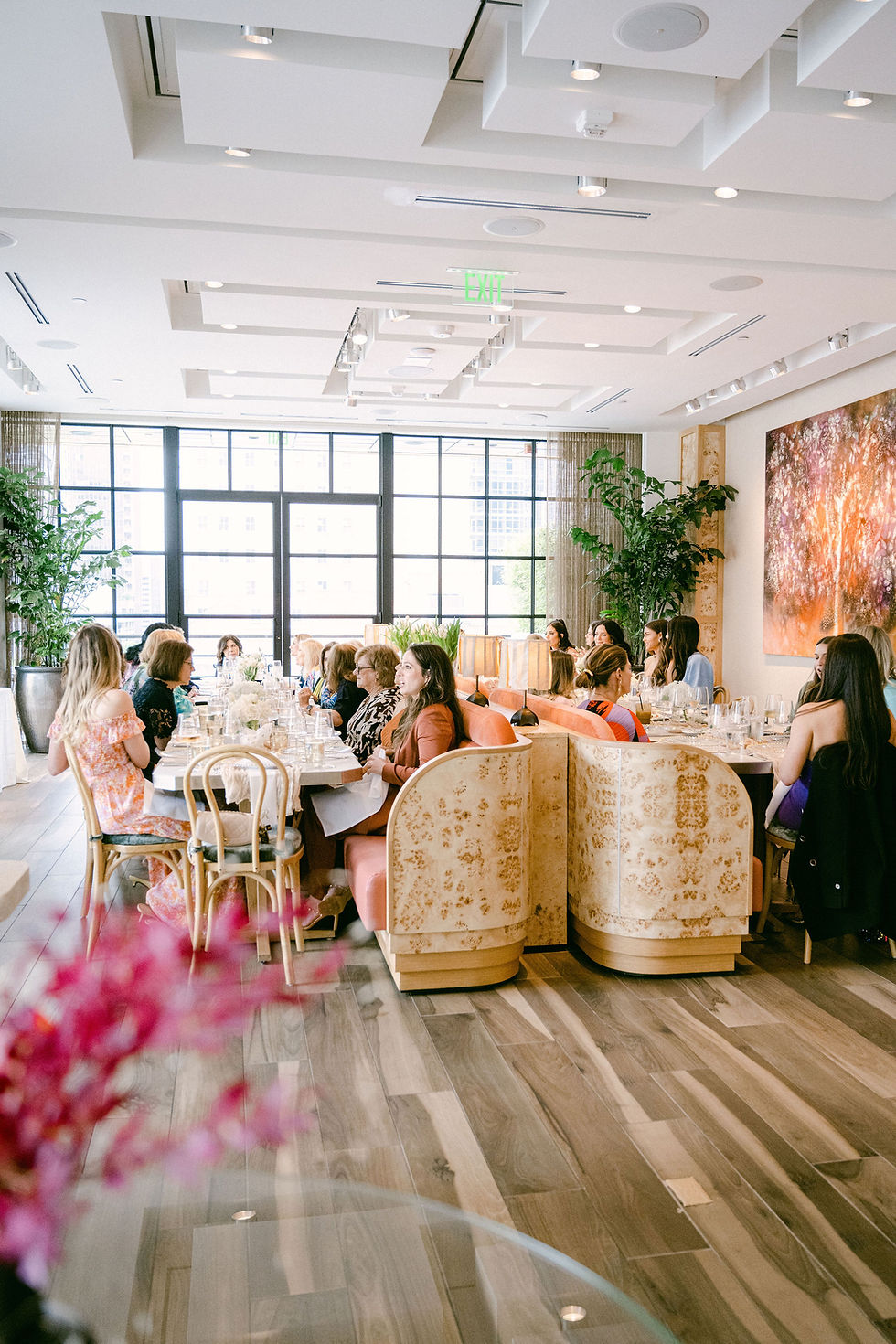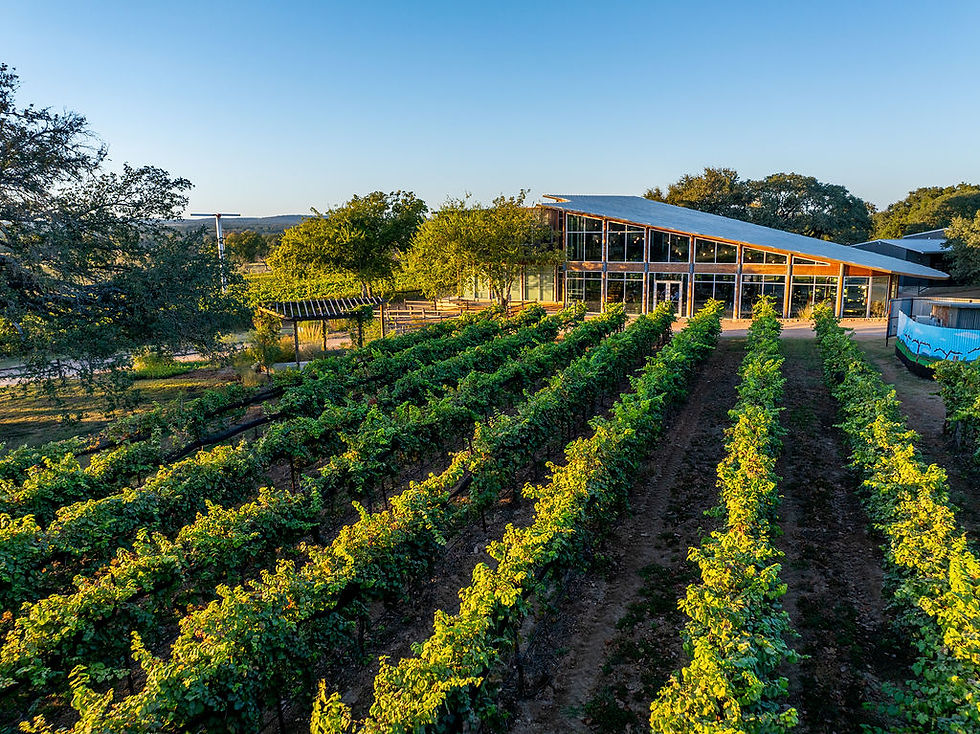SIBONEY CELLARS MAKES A FAST START IN THE HILL COUNTRY
- andychalk
- May 12
- 6 min read

by Andrew Chalk
Introduction
Drive out of Johnson City on US-290, west towards Fredericksburg, and Siboney Cellars is almost unmissable on the left-hand side of the road. Set raised, on an incline, above the surrounding vineyards is the Napa-quality tasting room adorned with floor-to-ceiling windows. Inside, the barrel room not only provides a floor for piano chamber concerts, it also underpins a crows nest room up in the rafters that is reserved for the winery’s members. Out front, the facility is set up for the Texas weather with a large patio following the interior tasting area.
Siboney Cellars is the work of Miguel and Barbara Lecuona, and silent investment partners. Barbara is responsible for everything that is inside the bottle. Miguel, everything outside. I had the opportunity to taste their current wine selection on a recent visit.
The Siboney Cellars Wines
To quote from the back label of their 2023 Roussanne, Bingham Vineyards, Texas High Plains “Every bottle from Siboney Cellars is, and always will be, 100% Texas Wine”. Indeed, Barbara gave up another profession to learn winemaking at John Rivenburgh’s winery incubator in Kerrville. The investment was worth it for the pride of creating a 100% Texas product. She also completed the studies in good time to have some wines ready for the winery and tasting room opening. As a result, Siboney has a suite of wines ready to taste, some from unusual grape varieties.
The Roussanne has the earthy tastes that one associates with that grape in its Rhône uses, albeit with a lighter body than in some other Texas examples, such as McPherson. The nose has tantalizing hints of white flowers.
Nebbiolo, which Barbara made in the 2022 vintage (2022 Nebbiolo, Lahey Vineyards, Texas High Plains), is a courageous choice of grape almost anywhere outside Piedmont or the Valtellina area of northern Lombardy. Most attempts don’t produce a wine that tastes like the grapes of Barolo or Barbaresco. Ironically, a rare exception came three years ago from down the road from Siboney at High Meadow Winery. Their 2019 Nebbiolo presented itself as an authentic Piedmontese.

Siboney’s Nebbiolo is riper-fruited than the dred-fruit products of Piedmont. It is also not as detectably high acid. It is aged 20 months in French oak barrels, 20% new, so that partly accounts for the organoleptic difference from Piedmont, where large, neutral, Slavonian oak barrels are the norm. Nonetheless, it is a pleasant wine.
So difficult is the grape to grow, in fact, we should not expect to see a wine every year. The grower, Lahey Vineyards, may be as foolish/intrepid as the winemakers who use the grape in that it returns a harvest about only once in every five years. There are easier, more productive, choices. Barbara loves the grape, but describes it as the hardest grape she has worked with, so she has created a marketing mechanism whereby it can be swapped in or out depending on availability. By naming the wine ‘Solo’ the name is a placeholder for a different Italian grape each year. So expect to see barbera, sangiovese and aglianico in other vintages.
Vineyards
Siboney also has their own vines. Currently just four acres, and very young (four years old), but there are 52 acres available to plant. They are intrigued by the soil variation. About 10 acres has a higher clay content, and the rest is primarily limestone. Current output is about 3,500 cases. They expect all or most of their Hill Country fruit to be estate in the long term but most of their grapes will come from the Texas High Plains, Barbara’s preferred sourcing location. Hill Country fruit has easier viticulture logistics but the climate (dry, windy, with large diurnal swings) on the High Plains makes the long journeys there and back during the growing season worth it. Her worry about the High Plains is the vine damage inflicted by dicamba (a Bayer Global herbicide used on GM cotton that destroys vines when it drifts).
Some of their cabernet sauvignon comes from fruit grown at Challis Vineyard in the Texas High Plains. Interestingly it is clone 47, a clone that originally came from Château Margaux in Bordeaux. Another source of cabernet over time has been Lahey Vineyards, where they grow clone 8, also a Margaux clone. Part of Barbara’s ongoing experimentation is separate fermentation and aging of different clones “because I am always interested in seeing the specifics from each vineyard”, The 2022 vintage that we taste is a 50-50 blend from the two vineyards, blended after barrel-aging, which she and Miguel found to be superior to each separate component.
I find the wine fruit-driven in the New World style with the oak aging just what some vintners call a ‘seasoning’ of the fruit. As I find out as we taste, this is a characteristic of Barbara’s red wines. She points out that, as a small winery, they need to go from vine to bottle in under a year, so this style may change. They plan to reach a steady state around twice their current output in time.
The 2021 Malbec also came from two clones and was vinified the same way, although in this case both clones came from Challis Vineyards. “The two clones grow side by side, they look different, they taste different, the clusters are different. Everything about them is completely different. So we keep those separate.” explains Barbara.
Most oak is French, but they have experimented with Hungarian oak for the petit verdot. Barbara sees it not that different thus far, although it has a tighter grain.
Grape Varieties
The winery started with an emphasis on Rhône varieties and still produces them, but has now added the full suite of major Bordeaux varieties. Cabernet sauvignon, cabernet franc, merlot, and malbec. Barbara admits that she is a fan of cabernet sauvignon and other Bordeaux varieties. “I love working with cab franc, carménère, and getting into all those guys and petit verdot.”
I stop her at the mention of carménère, the red-headed stepchild of Bordeaux, that established a new existence in Chile, where it has a claim to be the National Grape.
Siboney produced one using grapes from Lahey, the only grower selling it (one other winery has it as a captive crop). The wine sold out like hotcakes. “Unfortunately,” Barbara laments, “they got hit with a really bad hailstorm two years ago. It was devastating, so it wiped it out that year. It did not kill the vines, but it didn't produce that year. The following year, the crop was pretty much nonexistent, so we had a little bit, like enough to put into a blend. And then last year, we kind of doubled down on it. I want more carménère, and it just didn't make the season. We didn't buy it. We got rain right before harvest, and it never recovered from it, so we just didn't buy it. I'm hopeful that this year carménère makes a comeback because it has been one of our most popular varieties.”
I think carménère has great prospects in Texas, given its need for lots of sun to ripen, and that is exactly what we have. To put it another way, we should have a comparative advantage making this wine. “Exactly”, says Barbara. “This is funny. When we first made it, my husband (he cut his teeth in Bordeaux), he said hey, when we do our club releases, I always have a couple barrels of something that we're getting ready to bottle, and we taste out of the barrel. And he always says, what are you going to do this time? And I said, I'm going to do carménère. And he was like, no, you can't do carménère. It's got to be not that good. And I was like, oh, you just taste it. So he tasted it and said, oh, like I get it now. I'm like, yeah, we're in a completely different climate [from Bordeaux]. So this, it's absolutely beautiful when it produces. So it's one of my favorites.”
We taste the carménère and it reminds me of the better ones from Chile. It is not addled with the green pepper smells that beset the grape when it fails to get ripe. The pyrazines are present, but nicely in check, like a cabernet franc.
Take Home

Siboney Cellars is a winery just hitting its stride. It has made successively more successful varieties and I would expect to see continued improvement in the future. With their prime location on US-290 and their impressive tasting room they are poised for future growth. Definitely a winery to keep an eye on.
















Comments